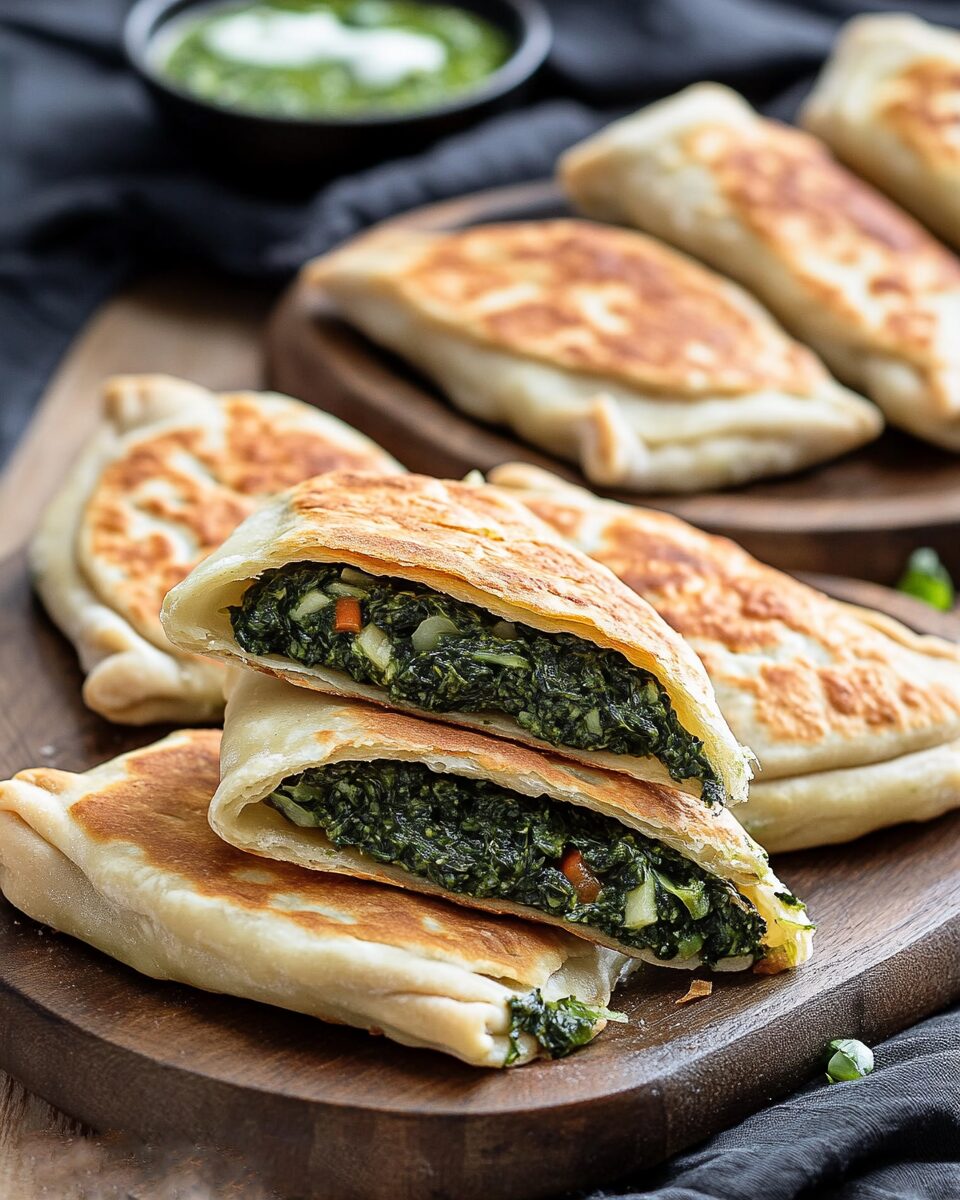The Afghan Spinach Bolani is a beloved street food and home-style dish, showcasing the warmth and simplicity of Afghan cuisine. This stuffed flatbread is filled with tender spinach, scallions, and fresh herbs, then pan-fried until golden and crispy. It’s a nourishing, flavorful option that’s easy to prepare and sure to satisfy. Perfect for sharing or enjoying solo, Bolani makes a delicious light meal or appetizer. Pair it with chutney or a garlicky yogurt dip for a complete Afghan experience. Whether you’re hosting guests or meal-prepping, these crispy turnovers bring comfort and culture to your plate.
Full Recipe:
Ingredients:
For the dough:
-
2 cups all-purpose flour
-
¾ cup water (adjust as needed)
-
1 tsp salt
-
1 tbsp oil
For the filling:
-
2 cups spinach, finely chopped
-
½ cup green onions, finely chopped
-
2 tbsp fresh cilantro, chopped
-
1 green chili, minced (optional)
-
½ tsp salt
-
½ tsp ground black pepper
-
½ tsp ground coriander
-
1 tsp lemon juice
For cooking:
-
3 tbsp neutral oil (vegetable or sunflower)
Directions:
-
In a large bowl, mix flour and salt. Gradually add water while mixing until a soft, non-sticky dough forms. Knead for 5–7 minutes. Cover and let rest for 30 minutes.
-
Meanwhile, prepare the filling by mixing spinach, green onions, cilantro, green chili, salt, pepper, coriander, and lemon juice in a bowl. Set aside.
-
Divide the dough into 6 equal balls. Roll each ball into a thin oval or circle (about 8 inches).
-
Place 2–3 tablespoons of filling on one half of each rolled-out dough, then fold over and press edges to seal. Use a fork to crimp if desired.
-
Heat 1 tbsp oil in a skillet over medium heat. Cook each bolani for 3–4 minutes per side, until golden and crispy, adding more oil as needed.
-
Serve hot with chutney or yogurt dip.
Prep Time: 30 minutes | Cooking Time: 20 minutes | Total Time: 50 minutes
Kcal: 180 kcal per bolani | Servings: 6 bolanis
Exploring the Flavors of Afghan Spinach Bolani: A Deep Dive Into Tradition and Taste
Afghan Spinach Bolani is more than just a savory flatbread it is a dish steeped in tradition, history, and vibrant flavor. Popular across Afghanistan and celebrated in Afghan diaspora communities around the world, Bolani (also spelled “Boulanee”) represents the heart of Afghan hospitality and home cooking. Whether eaten as a street snack, an appetizer, or a light meal, this stuffed bread offers a culinary experience that’s rich in texture, aroma, and heritage.
In this article, we’ll explore the origins of Bolani, its cultural significance, variations, nutritional profile, serving suggestions, and why it deserves a regular spot in your kitchen rotation.
A Glimpse Into Afghan Culinary Tradition
Afghan cuisine is a fascinating fusion of Middle Eastern, South Asian, and Central Asian influences. It reflects the country’s location along the ancient Silk Road, where spices, herbs, and culinary practices flowed freely between cultures and empires. Despite its geographical and cultural complexity, Afghan food has a humble and rustic essence. Ingredients are fresh and minimally processed, and meals are often centered around family and community gatherings.
Bolani is one of the most cherished dishes in Afghan homes. It’s traditionally prepared during festivals like Nowruz (Persian New Year), weddings, or special family occasions, but it’s also enjoyed year-round as an everyday comfort food. The beauty of Bolani lies in its simplicity handmade dough, a flavorful vegetable filling, and a golden crust achieved by pan-frying.
What Is Bolani?
Bolani is a thin flatbread that is rolled out, stuffed with a savory filling, sealed, and then fried on a skillet until crispy and golden. While fillings vary across regions and households, spinach is one of the most popular and accessible ingredients used. Other common fillings include mashed potatoes, leeks, lentils, pumpkin, and even ground meat.
Spinach Bolani, in particular, is a fantastic way to incorporate leafy greens into your meal while delivering bold flavors through fresh herbs and spices. It’s often served with a cool yogurt dip or cilantro chutney, which balances the savory, herbaceous stuffing with refreshing tang.
Cultural Significance and Symbolism
In Afghan culture, food plays a central role in hospitality. When guests visit a home, offering food is not just customary it’s an expression of respect, love, and generosity. Dishes like Bolani exemplify this tradition because they’re shareable, easy to prepare in batches, and suited for all ages and dietary preferences.
Making Bolani is often a communal activity. In traditional Afghan households, multiple generations gather in the kitchen to knead the dough, prepare fillings, and shape the flatbreads. This process strengthens family bonds and reinforces cultural values passed down through the generations.
During holidays, Bolani is offered as part of larger feasts, where it’s surrounded by other staples like Kabuli Pulao (spiced rice with lamb and raisins), Mantu (steamed meat dumplings), and Shorba (a hearty meat and vegetable soup). Its versatility also makes it suitable for Suhoor or Iftar meals during Ramadan.
A Plant-Based Delight
One of the reasons Spinach Bolani has gained international popularity especially among vegetarians and vegans is its plant-based profile. Unlike many other stuffed flatbreads from nearby regions (such as Indian parathas, which may use ghee or paneer), Bolani can be made entirely vegan without sacrificing flavor.
The spinach filling is typically enhanced with green onions, cilantro, chilies, lemon juice, and a simple blend of spices like coriander and black pepper. The result is a punchy, aromatic mixture that contrasts beautifully with the crispy dough exterior.
From a nutritional standpoint, this dish is relatively healthy: it’s high in fiber, provides a good dose of iron and folate from the spinach, and is low in added sugars or saturated fats. For an even healthier option, some cooks opt to bake the Bolani instead of pan-frying or use whole wheat flour for added nutrients.
Variations Across Households and Regions
While spinach is a beloved classic, Afghan Bolani is incredibly versatile. Here are a few popular variations:
-
Potato Bolani (Kachaloo): Mashed potatoes spiced with turmeric, cumin, and green onions. A comforting option that’s hearty and satisfying.
-
Pumpkin Bolani: A fall favorite using mashed or grated pumpkin with a touch of cinnamon and spice.
-
Leek and Green Onion Bolani: More pungent and aromatic, this version is a staple in northern Afghan provinces.
-
Lentil Bolani: A protein-rich variation using cooked red or brown lentils.
-
Meat Bolani: Occasionally, minced lamb or beef is added to the mix, though vegetable-based versions are far more traditional.
The dough and cooking technique remain largely the same across variations, making Bolani an ideal canvas for culinary creativity.
Serving and Pairing Suggestions
Bolani is best enjoyed hot off the skillet, when its edges are crisp and the filling is warm and fragrant. Traditionally, it’s paired with one or more of the following:
-
Garlic Yogurt Sauce: Made by mixing plain yogurt with crushed garlic, salt, and mint. This creamy dip cools the spice of the filling and enhances the dish’s richness.
-
Cilantro Chutney: A zesty green sauce made with cilantro, lemon juice, garlic, and green chili. It adds freshness and a citrusy bite.
-
Simple Tomato Salsa: Chopped tomatoes with onions, herbs, and lime juice can add a bright, acidic element.
You can serve Bolani as an appetizer, a side dish, or a light lunch. Cut them into halves or quarters for party platters or enjoy a whole one as a personal treat. They also travel well and can be packed for picnics or school lunches.
Modern Takes and Global Popularity
With the global rise in demand for vegetarian and ethnic street food, Bolani has found its place in food trucks, farmers markets, and fusion cafes outside Afghanistan. Chefs are putting their own twist on it, adding cheeses, using sourdough or gluten-free dough, and incorporating new herbs and spices.
Social media has further amplified its appeal. Food bloggers and YouTube creators from various backgrounds are now sharing homemade Bolani recipes, often experimenting with air fryers, baking techniques, or plant-based dipping sauces.
The dish’s popularity also reflects a growing appreciation for Afghan cuisine in general. As the world becomes more connected, dishes like Bolani act as culinary ambassadors, introducing people to the hospitality and heritage of Afghanistan.
Advertisement
Why You Should Make Bolani at Home
Bolani may look intricate, but it’s surprisingly beginner-friendly. With just a handful of pantry staples, you can create a dish that feels indulgent, comforting, and deeply rooted in tradition. It’s an excellent choice for anyone wanting to:
-
Explore a new global cuisine
-
Add more vegetables to their meals
-
Make budget-friendly, meatless dishes
-
Host a themed dinner night
-
Create food that encourages sharing and conversation
Homemade Bolani can be stored in the fridge for a few days or frozen for longer shelf life. Reheat on a skillet or in an oven to restore crispiness.
Conclusion:
Afghan Spinach Bolani is more than a recipe it’s a story told through food. It speaks of resilience, community, and the warmth of home. With each bite, you’re tasting centuries of tradition and a culture that values flavor as much as fellowship.
Whether you’re discovering Bolani for the first time or reviving childhood memories through food, this dish delivers comfort and culture in every golden, crispy fold. So the next time you’re craving something soulful and satisfying, let your skillet transport you to the vibrant kitchens of Afghanistan.

